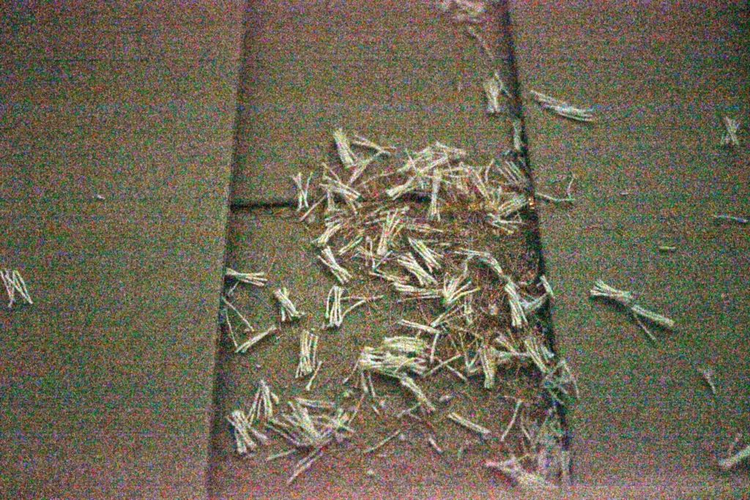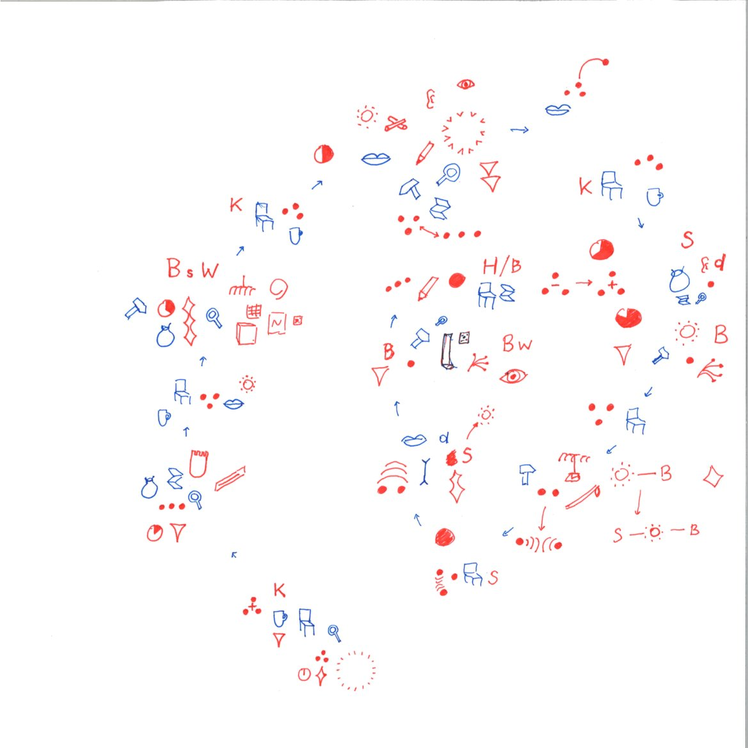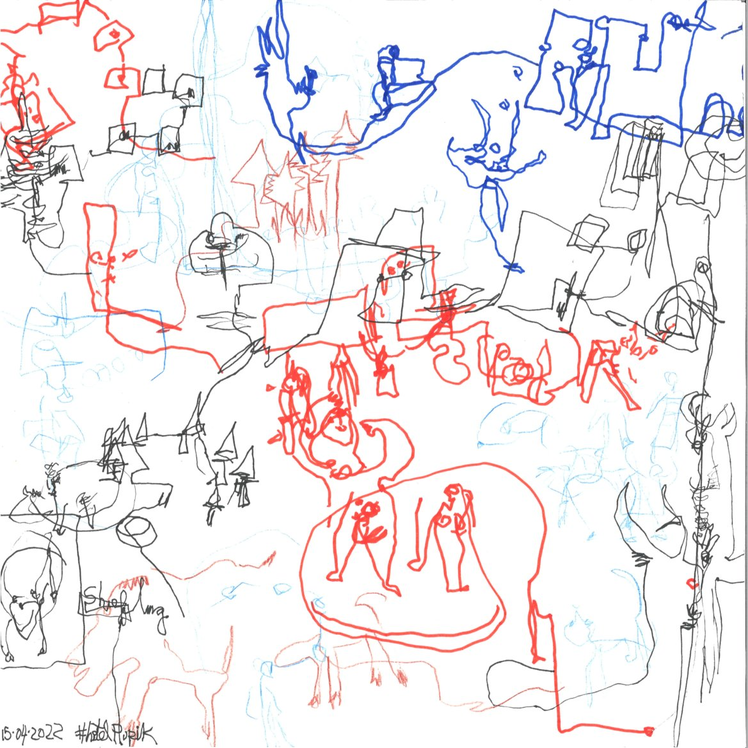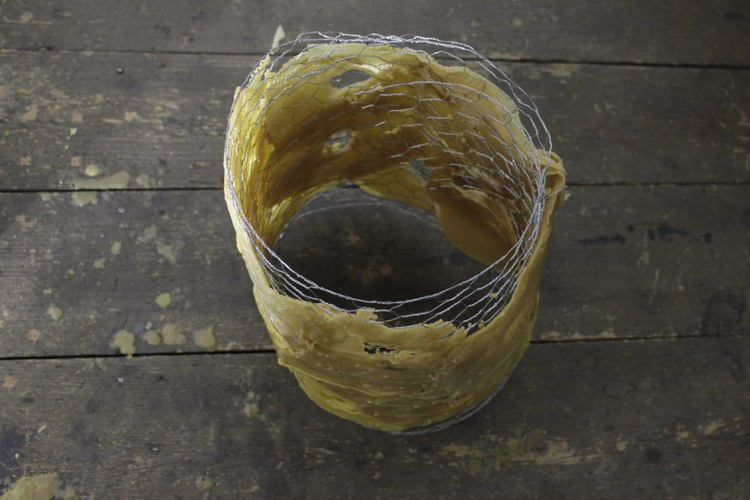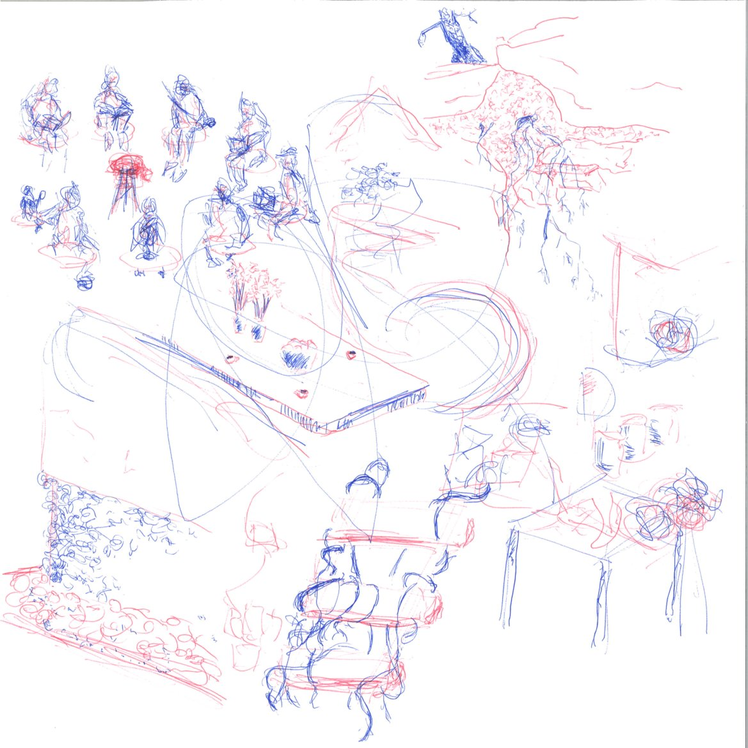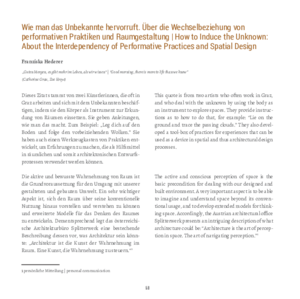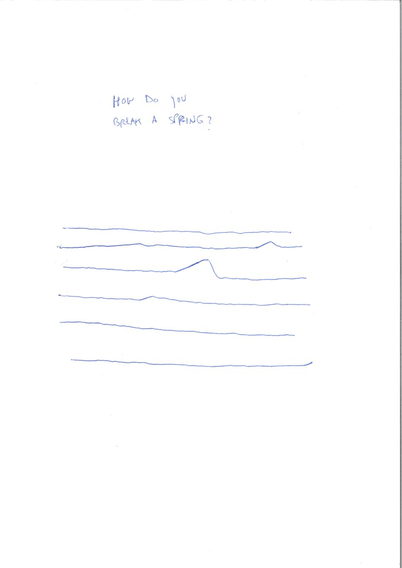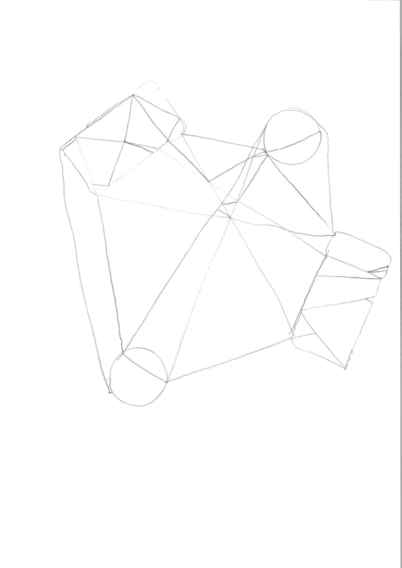This page assembles materials produced in group situations. It also contains various dialogues held in the online preparatory phase of the project.
{hhr 220311}
{hhr 220325}
{hhr 220406}
{220306}
Formulations
What are possible “formulations” of new types of collaborative artistic and artistic-research work? This could be concepts and idea, but also examples from our past experiences. How do we describe what we imagine to be a different kind of collaborative process that allows us to work in parallel, to conceive different things that can co-exist, or perhaps merge in a new way that preserves the individuality brought in by everyone? (Or to take even a step back, to discuss what “individuality" would be, if and how it is desirable, and how it relates to a process of commoning. What is the kind construction of a work process that you would like to develop or “test”?
Materials
The term “material” of course has many meanings (and different interpretations). An idea can become material, a glass pane can become material, a social constellation can become material, a piece of software can have material consequences. What is the “stuff" you work with? Can material even be distinguished from "composition", “tools”, “form”, and are those distinctions important? Rather than engaging in a game of definitions, perhaps we can just throw in everything that seems relevant to our practices. What would we bring to the studios in April / online, what are we going to work “with”? Are there materials we’d like to share?
{date: 220211}
We were talking today (dp, hhr, jkk, nc) about the interpretation of the Swap Space title. Jackie thought of a book swap shelf. Hanns Holger of the swap space on a computer that is used when there is too much stuff, and things need to temporarily move to this placeholder swap. Naya thought that it would be nice to allow others to work with the by-products no longer used by somebody. We thought that a “blank space” could function as such a place, a residual repository, where we can leave elements that come out of a process but that we are no longer using or pursuing, for others to pick them up.{hhr 220325}
{sf 220403}
quick note from shane: agreed re cables and fibres. They are the markers of infrastructure. But so far I have seen more about transit and windows, flat surfaces, that are triggering something.
{sf 220317}
Some great ideas here, thanks Franziska. I like the following points, which I'd love to discuss more:
1) "To arrive in a space requires actively taking possession of it." – I am not sure I love the idea of posession, unless we're talking about ghostly or spiritual posession, but the importance placed on arrival and ownership is definitely worth considering. I wonder how much people felt this type of posession when they arrived in ships in the "new world", and how different that felt if you were above the hold on the ships, or below the hold in chains.
2) "Working with as much as on what we come upon by chance, in conjunction with what we bring along, causes for unforeseen yet nonetheless intimate moments of varying density to arise."
I have written something similar in "materials" as I am thinking about this too. What do we find on arrival? What can we use? If I was a migratory critter, what would I seek in my immediate surrounds?
Book link: www.politybooks.com/bookdetail?book_slug=living-as-a-bird--9781509547265
Article link DOI: 10.1163/9789462096448_004
Here are the references to Nancy “Being Singular Plural” (2000) and Ahmed “Queer Phenomenology” (2006):
{sf 220317}
I'd add to this Maria Puig de la Bellacasa's really interesting thoughts on contact and care. In her book Matters of Care, she comes to a fascinating point on the idea of contact, technology, and care between human and nonhuman (also drawing from Ahmed if I remember right). Her key point that she makes early on is that touching is not only performed by one body, it is always by at least two bodies simultaneously. The thing being touched is also performing touching.
Shane Finan 16/03
Thoughts on materials, supply chains, abundance, biocomputers
Materials are definitely causing me some dilemmas at the minute. They are a crucial part of the supply chain for making work. On the one hand, I need to choose the right materials to respond to this project. On the other hand, I have no idea what these might be until the project starts. This leads to a blockage, a bottleneck in work before I arrive. Either I bring/purchase in the hopes that something might be useful, or I wait, risking not having things I need on time (or at all, as materials can sometimes take a long time to arrive). Right now too, materials are increasing in cost so rapidly that it is worrying to wait too long (although inevitably by thinking like this and buying rapidly, I would only contribute to the rising cost of materials by being just one more purchaser rushing to make a withdrawal from scarcity).
All of this is a little challenging, and also exciting. Hotelpublik will only accept whatever we bring with us. If we come unprepared, it will only offer whatever is there. There won't really be a chance to bring anything after we arrive. There are many parallels with the idea of migration here.
I have just moved house, after four years in one place. As an artist and with a partner who is a craftsperson, chef and food grower, we tend to accumulate things. It took four loads in my small van and one load in a large van to move all our possessions. On top of this, I filled my small van four more times with material for recycling and waste (including many of my precious electronic goodies that I gleaned from those same recycling dumps down through the years). This seems a preposterous collection of materials to have gathered over four years, living in a small cottage in Wicklow, Ireland.
What do birds carry with them when they migrate? What do animals move with them? Are all these movements intentional or do hitchikers like parasites also travel? What will I bring, both intentionally and unintentionally, on my body and my clothes and in those many technologies that I carry on me? Would it be possible to respond to the spaces at Hotelpubik or Graz by using only materials that are close to hand?
I often build artworks from things that I find on-site (including recycled materials like timber or electronics) mixed with other materials that I bring from outside (such as computers, components, paint, etc.). But as my practice uses technology so prominently, it seems unlikely that I will be able to only use local materials. I don't think I can build a computer from grasses or birdsong, although I have recently completed a few experiments growing slime moulds and investigating sensor data from fungi. So maybe biocomputers could form part of an output. Something built from those sensors that already exist in a place, if only we can recognise them early enough upon arrival.
Book link: www.sup.org/books/title/?id=643
Book link: www.dukeupress.edu/Queer-Phenomenology
{sf 220317}
I like this point about the view of electronics. I am thinking a lot about the things that we cannot see, but of course there are many things that we can see clearly if we just look. There is an obsession sometimes with hiding wires to make objects look more "authentic" (or perhaps magical). I have moments where I like the wires, and others where I don't. Of course, my most recent work with Púca in the Machine was nearly all wires on show, but it was about the unseen and electricity so I suppose there was a connection.
-Shane
{NC 18.04.22}
Answering HH on needle touch,
I wonder how to measure the extension
of touches,
some contacts expand and transform
into braids, some others reduce to a point...
Yesterday I've heard my mum talking to Shane
about Tunga...maybe some contacts are like his
braids....
Simultaneous Writing
When thinking about collaborative writing, how could that involve simultaneous practices? In a more general sense, we we collected various traces created in the parallel group exercises.
{hhr 220304}
"Cognitive map" exercise My week in Schrattenberg, created by Johanna Lettmayer on 15 April 2022. Each map took 40 minutes. (some maps have been drawn at a different day)
SF updated thoughts on materials, 03/04/22
Screens and windows
Lev Manovich wrote about how the screen in technology stems from the landscape painting in art, and the landscape from the window. This, he argues, is why screens are usually rectangular. On my journey here, and since arriving, I have been thinking a lot about windows.
The window protects from air and cold. It also obscures the senses, placing value on visual over other sensory understanding. We use windows often, of course (phones, cameras, laptops) and I don't want to tread over old ground, but challenging this "border" is the first thought that I have for materials since arriving.
How much is seen through a window? Is something forrbidden behind one if we see a lifestyle or a circumstance through online media?
{hhr 220322}
As I was just reading Pauline Oliveros' keynote “Quantum Improvisation: The Cybernetic Presence”, I was thinking of the relationship between what we are doing and improvisation (Naya sometimes said “jam”). For instance this quote:
“What in fact does happen when a creative musician makes new music? How can it be new or free? What is it free of? What could be new about it? What is happening with a solo improvising musician? a group? The soloist gives herself feedback and enters a dialogue with herself and musical space - the group stretches the possibilities for dialogue and new relationships come about creating a myriad of new possibilities even though the course of the music - new as it may be - will flow with ineluctable inevitability.”
Later, there are also other interesting relations to space, for example the image of the universe as a torus. I come back to the depiction of extimacy as a torus by Gabriel Tupinambá, and a tentative "torus chain” perhaps formed by multiple beings?
The title refers to quantum computing and thus to simultaneity.
“Ambiguous consciousness would mean the ability to perform in more than one mental state simultaneously in order to reach or bridge past and future as an expanding present. There could be new sound combinations anchored by increasing order even though choices might seem incompatible.” (my highlight)
shane's black circle of remembering
the following are things i promised i would send while at hotelpupik:
1) while talking to franziska, i mentioned the brilliant paper by Wim Nijenhuis in the critical maker's reader by the institute of network cultures. it's on page 127 at this link
2) i mentioned my artwork about how trees and fungi communicate, and alisa, naya and consuelo were all interested. see the documentation video here
3) i mentioned to someone the brilliant installation deep sea blue surrounding you by laure prouvost
4) watch leos carax's films, especially holy motors
{hhr 220309}
{hhr 220322}
Merleau-Ponty using the term “chiasm” to describe the coming together and intertwining:
“the chiasm is a structure of mediation that combines the unity-in-difference of its physiological sense with the reversal and circularity of its literary usage … A paradigmatic example of chiasmic structure is the body’s doubling into sensible and sentient aspects during self-touch." (source)
{hhr 220309}
{NC 18.04.22}
After the intensive week of work in Hotel Pupik
and two days to recover from the massive experience,
it became obvious to me that through SWAP SPACE and SIMULARR,
I have signed to re-observe collective work
by sealing a complete transparency policy around my personal realm.
My private dialogues,
bed conversations,
are now not only part of the investigation,
but also constitutive dimension of the dialogue with others.
We, HH and I, as a couple, collaborator, and research team,
have the difficult task to understand our internal dynamics to
create spaces of togetherness among ourselves and others.
So, it is not only about understanding the dynamics but the documentation.
All the conversation reminded me of a book that I've read long ago:
Artistic Bedfellows...it might be interesting to go back to it,
it has a lot of information on collaboration and also on the failures of the practice...




